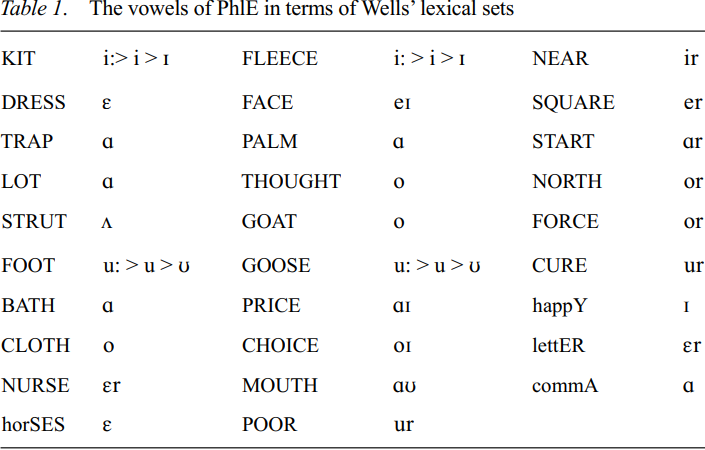


 Grammar
Grammar
 Tenses
Tenses
 Present
Present
 Past
Past
 Future
Future
 Parts Of Speech
Parts Of Speech
 Nouns
Nouns
 Verbs
Verbs
 Adverbs
Adverbs
 Adjectives
Adjectives
 Pronouns
Pronouns
 Pre Position
Pre Position
 Preposition by function
Preposition by function 
 Preposition by construction
Preposition by construction
 Conjunctions
Conjunctions
 Interjections
Interjections
 Grammar Rules
Grammar Rules
 Linguistics
Linguistics
 Semantics
Semantics
 Pragmatics
Pragmatics
 Reading Comprehension
Reading Comprehension|
Read More
Date: 24-3-2022
Date: 2024-06-21
Date: 12-4-2022
|
Table 1 summarizes the vowels of PhlE in terms of Wells’ lexical sets.

Since there is considerable lectal variation further details are provided in Table 2, of the three PhlE varieties alongside those of gAmE. In table 2 a minus sign (-) represents a set present in gAmE but absent in the PhlE variety. Substitutions made for those absent phonemes are enclosed in parenthesis in the last column of the tables. As the U.S. phonological tradition generally classes /eɪ/ and /oʊ/ with the monophthongs, I have left them in table 2, whilst excluding the other diphthongs.


The vowels of the acrolect group resemble those of gAmE except for PALM which is low back in the former but low central in the latter. The de-stressing of vowels rendering them [ə] or [ɪ] in rapid speech also occurs in this group. The generation study of Gonzalez, Jambalos and Romero (2003) shows the increased use of schwa in unstressed syllables.
The mesolect group has six stressed vowels plus schwa. [i] (or [ɪ]) is used for both KIT and FLEECE. These short vowels are in free variation with [i:]; no words are distinguished purely by length. Similarly [u] (or [ʊ]) is used for both FOOT and PULL; with once again some free variation with the long vowel [u:]. [o] is used for both CLOTH and THOUGHT; [ɑ] for PALM; and schwa in free variation with [ɑ] for commA. The other vowels in the inventory of the mesolect variety are [ε] in DRESS; [e] and ‘stressed schwa’ /Λ/ in STRUT. Some differences from gAmE pronunciations occur as in [o] in model rather than [ɑ]; and [ɑ] in bag instead of [æ]. The vowels of the mesolect group are given full value even in unstressed syllables, in contrast to acrolectal norms.
The basilect, on the other hand, has three vowels. [i] is used for KIT and FLEECE as well as DRESS vowels. [ɑ] is used for TRAP, NURSE and About. [u] is used for FOOT and GOOSE as well as for CLOTH and FORCE. Thus, in this variety, trap is pronounced [tarap], north is rendered [nurt] and nurse, [nars]. Like those of the mesolect group, vowels in polysyllabic words are not de-stressed in the basilect.
In spontaneous speech, vowel length differences between monophthongs and diphthongs are not evident in the mesolect and basilect varieties of PhlE. As far as vowel length in contrastive pairs like feel/fill and pool/pull is concerned, mesolectal speakers do produce them distinctly in focused, deliberate speech. However, in other styles [i] and [i:] and [u] and [u:] do not contrast; there is a slight tendency for the long vowels to be preferred under the influence of Philippine languages.
|
|
|
|
تفوقت في الاختبار على الجميع.. فاكهة "خارقة" في عالم التغذية
|
|
|
|
|
|
|
أمين عام أوبك: النفط الخام والغاز الطبيعي "هبة من الله"
|
|
|
|
|
|
|
المجمع العلمي ينظّم ندوة حوارية حول مفهوم العولمة الرقمية في بابل
|
|
|